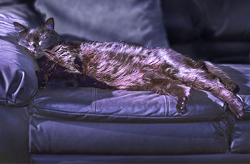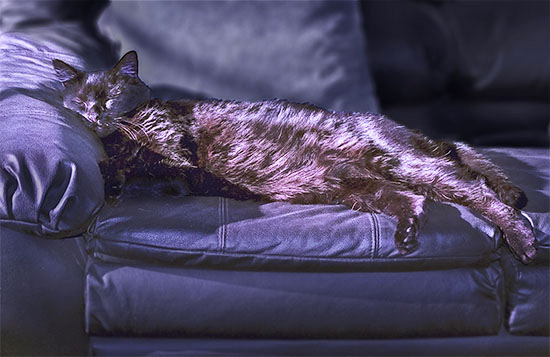 My Grandpa and cat told me naps are important. Now smarty-pants scientists also say ‘power naps’ improve cognitive functioning, increase reaction time, learning, efficiency and health. Result? Get more work done.
My Grandpa and cat told me naps are important. Now smarty-pants scientists also say ‘power naps’ improve cognitive functioning, increase reaction time, learning, efficiency and health. Result? Get more work done.

My grandfather didn’t speak much English, and my cat, well, even less, but they told me how important naps were. One of my earliest childhood memories is hearing my grandfather’s booming voice and his Italian command “pisolare, pisolare”, and seeing his big gnarled hand coming down to snatch mine and tug me over to the couch.
We would then proceed to lie down together and take a short nap. We knew a ‘power nap’ would improve our cognitive functioning, increase our reaction time, learning, efficiency, and health.
Ok, I’m lying, we didn’t know any of that. But smarty-pants scientists have discerned all that and more in study after study. We just knew it gave us more pep to proceed with grand adventures and mischief around our Bronx neighborhood or the serious work of creating coloring book masterpieces. When serious work is confronting you, getting the project done faster and better can be achieved by sleeping on the job.
BENEFITS OF A POWER NAP
First let’s get a handle on what a ‘power nap’ is and then how best to pull it off. Regarding duration time, many sleep experts advise to keep the nap between 15 and 30 minutes.
Sleep comes in five stages. If your nap takes you from stage 1 sleep (just drifting off) to stage 2 (brain activity slows), you will wake up feeling energized and more alert. If your nap takes you into stages 3 and 4, which is deep sleep, you will not wake easily and will feel groggy and tired.
Sleep stage 1 typically lasts about 10 minutes and stage 2 lasts another 10 minutes. That makes the 20-minute nap ideal for most people. Speaking from my two decades of personal slumbering experience, I find between 20 and 30 minutes is ideal.
INCREASES YOUR EFFICIENCY
Now I know what some of you are thinking–‘I can’t spare any time–I have piles of work piling up–emails to email–deadlines, deadlines and deadlines’. But the thing is, you’re going to get all that stuff done faster by stopping for a short time span because the nap increases your efficiency.
So if you sleep for 15 minutes and maybe increase your efficiency by a conservative 15% for the rest of the work day, say four hours, you’re going to, in effect, save 36 minutes, so you’ll actually come out ahead by 21 minutes. And whatever you’re doing is probably going to be done at a higher quality level to boot.
GOOD FOR HEART HEALTH AND STRESS REDUCTION
Say you’re not a numbers nut–but instead a health nut–there’s tons of evidence that this short break provides numerous health benefits. For one, it decreases the risk of dying from heart disease. That’s nothing to snore at. A large, six-year study of Greek adults found that people who took a siesta at least three times per week had a 37 percent lower risk of heart-related death.
Research also shows that a nap significantly reduces stress, and we know stress can lead to all sorts of deleterious issues. Naps also improve cognitive functioning, boosts your patience, improves reaction time, increases learning, boosts creativity, makes you more alert and in general improves your overall mood.
Although our own US culture generally frowns upon mid-day sleep, many others around the world smile upon it. Italians like my grandfather almost consider it mandatory. When I was in Italy I remember it seemed like the country virtually shut down for part of the afternoon, especially when I was outside the big cities. And this snoozing has been tried and tested for hundreds of years in many other cultures.
BEST TIMES TO DO IT
Regardless of culture, humans are manufactured to shut down in about 8 hours after waking. Most people experience a natural increase in drowsiness in the afternoon. It seems that between one and three o’clock is the best time period to nap. Once you get to 4 o’clock or after, the nap can interfere with you ability to fall asleep at night.
The best time will vary among individuals and vary a little from day to day. Your own mind/body clock will tell you when, if you’re open to listening to it. Or if you’re open to listening to a psychic cat.
My furry office manager and lucky black cat, JR, had an uncanny ability to sense when I needed a break. When I would start fading in the afternoon, he’d leap up on my desk, lay across the computer keyboard and meow to take a nap with him. If I would lift him off the keyboard, he would lay right back down across it and meow in a more exasperated tone. He refused to budge until I got up, and as soon as I did, he did.
Then JR would follow me to the sofa or bed, lie across my chest and purr contentedly that I was smart enough to follow his advice. Cats are indeed napping experts and I did well in heeding his guidance .
So whether you put more weight in a big bunch of smarty-pants scientific studies, or an old grandfather and his ancient culture, or the expert opinion of felines–everything points to napping for enhanced work and better health.
